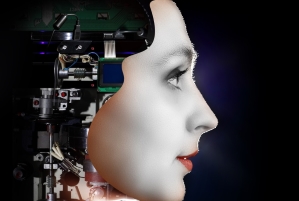
Lie: Passive use of the internet is harmless.
Truth: Passive use of the internet is participation in hidden, mass, personal data collection, analysis, and control and insidiously leads to idolatry.[1]
At the time of this writing in 2018, the majority of people I see walking about carry their smartphone in hand. They’re either texting, surfing, watching, talking or just having it at the ready. And if it’s not in hand it’s not far from them. This obsession is well documented, both the good and the bad. The good: we’re able to connect and relate more often and easier with the people in our lives. The bad: people go about driving distracted, walk like zombies, two- and three-year-olds play deftly with their iPads, people ‘date’ while glued to their phones. And the pitiful reality is that a growing number of people sleep with their phones so that it becomes their first and last touch of their day.[2] It’s all becoming a bit too much.
I’ll let you in on a secret: these ‘smartphones’ are not actually phones at all (more on that later).
But first of all, what do I mean by passive use?
By passive use I mean reading, watching or interacting with web content, without need or purpose, and purely at the direction of automated systems. Most do this all the time. Passive use itself is fundamentally idolatrous because – in that moment – we implicitly and blindly trust a non-human, superior system to guide us, feed us, protect us, and inform us. We passively trust it by virtue of its size, scope, comprehensiveness, speed, accessibility and cultural relevance.
The trend is certainly toward more passive use, as opposed to intentional use. This will especially take off when the Internet of Things (IoT) ramps up. Out internet transactions will nearly all be reflexive and transparent to us.

It may include:
- simply surfing the web – randomly clicking on news articles, allowing big data/AI systems to determine the scope of what you read, watch or interact with.
- allowing visual/graphic content to seduce you into consuming more and more and more..
I’ve broken this article into three parts to make its digestion easier. The three parts are:
Part 1: The data collection and control system. An overview of the four parts to this system and how it works.
Part 2: The consequent spiritual problem. The growing spiritual and even existential problem of passively using the system which we must recognize and seek God for answers.
Part 3: The reality-warping problem. How the internet is consuming all, including us, and is transmuting the entire world so that it becomes more difficult to distinguish between the real and the artificial.
Since it takes a while to link all the parts of this argument, here’s my complete argument in one paragraph:
Passive use of the internet leads, ultimately, to a deep idolatry because it is a careless but legal agreement to mindlessly participate in and transfer ourselves (via our data) to a deceptive, god-like, reality-altering, tyrannical, non-human and alternate-world-creating system. This system promises an alternative, digital salvation, but is actually designed to trap us by narrowing our options and, physically, mentally and emotionally impairing us until we become completely dependent on its control systems.
You may think I’m overstating the case. But even if you think that, please stay with me to the end. You may be surprised by what you learn.
The Data Collection and Control System
We have to be careful to accurately define our terms. We need to clearly understand what we’re dealing with. What’s really happening in this strange tableau of near zombification that I described earlier? People are, only at a subliminal level, somewhat aware that government and corporate entities use their devices to collect their personal, behavioral data.
For our purposes, three basic kinds of data exist. Let’s use the email as an example artifact to parse the kinds of data that can be collected:
- metadata – ‘data about data’ includes time sent, language, ‘to’ and ‘from’ email addresses, number of words, etc.
- content data – the message body of the email – what the email actually says.
- behavioral and psychological data – the typing speed and pattern in which the email is composed, etc.
We were originally told that the only data collected was the metadata – data like: who we call (who’s in our network), where we go, what we search for and what websites we visit. But since the Edward Snowden revelations[3], we now know that the data collection goes much deeper. It’s not only who you call or how long you talk (the metadata), but what is actually said – it’s the content of the conversation that is also tracked, stored, analyzed and ultimately used to control.
And it’s not only metadata and content data that’s tracked; the third type of data is even more onerous: the behavioral and psychological data is also increasingly collected – data like: scrolling speed, conversational speaking rates, sleep patterns, driving speed, facial expressions, etc.
This kind of tracking is no longer conspiracy theory. Mass surveillance on the American people has now been going on since at least 1994 with the passage of the Communications Assistance for Law Enforcement Act (CALEA). I’ll explain more in Part 2.
So a long-term surveillance and data collection effort continues. Various governments and corporations now develop, maintain and share detailed profiles on practically every living person.
For example, Cambridge Analytica, a leading big data-driven marketing firm boasts (quoted verbatim from their online marketing About page):
We have up to 5,000 data points on over 230 million individual American consumers. By combining these data assets with your own customer data as well as a proprietary research instrument, we build custom target audiences, which enable us to engage, persuade, and motivate individuals to act.
We use peer reviewed and proprietary models of behavior, such as the OCEAN[4] scale of personality, to understand the nuances of customers and their decision-making. This insight allows us to create individually tailored messaging that engages individuals based on their unique psychological profiles.[5]
Cambridge Analytica boasts up to 5000 data points on over 230 million individuals. But, you say, so what? Yes, it’s creepy, but as long as we stay out of trouble, why should we care? We should have nothing to hide, right? Before we accept such a trite rationale let’s stop and think.
That logic contains many problems, but it also assumes a fundamental flaw. To see that, we have to step back to see the forest, not just the trees. We’ve got to ask: How does this work? What is the nature of this data collection effort? What are we really doing when we (passively) participate in it? What is the data used for? Do they compile these detailed profiles simply to tailor better ads? to give us better search results?
To answer those questions let’s look closer at the four major components of this data collection program:
- Smart device: Smartphone, tablet, digital assistant (for example, Amazon’s Alexa), computer, or other ‘smart’ input devices, including wireless sensors. Some would make this a fifth component.
- Internet and wireless service providers: AT&T, Verizon, Sprint, T-Mobile, Comcast – the backbone infrastructure that enables our use of Google, Amazon and Facebook.
- Data collector/processor: Google, Twitter, Facebook, Amazon, Microsoft, Instagram and many other major social media corporations who offer free services in exchange for users’ data. These data collectors capture our behavioral data (unbeknownst to us), and sell it as prediction products.
- Control system: medical, food, health, education, finance or other system that use big, behavioral, location, etc, data sets in order to create digital systems that offer personalized and predictive products or services within their domain. The best control systems become so powerful in their own right that they end up promising a kind of ‘salvation.’ More about that in part 2.
Now let’s look closer at each of these components:
1 What is a ‘smart’ device?
As I said earlier, the smartphone is not actually a ‘phone’; it is essentially a personal robotic device – a personal digital ‘assistant.’ The actual phone, that is, the discrete telecommunication application that runs on the smartphone is now only one of thousands of applications. The phone application is actually falling into dis-use.
The smartphone is a robotic control device because it can perform many of the functions that characterize a rudimentary robot.[6]
- it performs specialized, personalized instructions, even verbal instructions.
- it learns and adapts its capabilities to my personal behavior.
- it is ‘intelligent’ and responds intelligently to my questions and commands.
- it can organize my time, routes and activities by observing and collecting my personal data.
- it anticipates my needs and suggests improvements to my schedule, routines, messages, tasks, etc.
- its multipurpose functionality makes it endlessly adaptable to other add-on devices which serve any number of purposes: medical, health, diet, language learning, finance, etc.
With the advent of the ‘Internet of Things’ (IoT), the smart energy grid and the 5G telecommunications network build-out now going on, our smart phones will become even more powerful. Any ‘smart appliance’ will broadcast its data to our phones or to a home digital assistant, such as Amazon’s Alexa.
So your smartphone is a well-disguised and an intelligent control device that scoops up the data – most importantly your behavioral data – in your personal environment by the gigabyte, and then pours it into any number of big-data funnels.
2 What are internet and wireless service providers?
The powers of the world have thrown an invisible net around us. It’s the system of copper wire, fiber, satellites, cell towers, ‘smart meters’ and now with the 5G network build-out, the ‘small cell,’ which is now – in 2018 –proliferating across our cities, towns and neighborhoods. Service providers are the unexciting back-office tangle of wires and software that moves our data from point A to point B. It’s a sophisticated conglomeration of technologies and software protocols and computer hardware that enable various devices to download and upload data over wires, fiber or EMF-powered/pulsed air. Without it, no ‘smart,’ device could work. Major carriers include AT&T, Sprint, T-Mobile, Verizon and Comcast.
3 What are data collectors/processors?
Data collectors and processors are the major data and communications corporations with their applications that run on the service providers. Chief among them of course, is Google’s Search application and its constellation of other products and services, most of which are offered free of charge.
If you’ve used Google, you’ve already agreed to their Terms of Service, all 2,028 words of it. From Google’s Terms of Service:
By using our Services, you are agreeing to these terms. Please read them carefully. . . . These terms control the relationship between Google and you. [emphasis added][7]
Like it or not, as soon as you do a simple Google search, or set up a Gmail account, you establish a legal and contractual relationship controlled by Google. Further, regarding the content or data, Google says,
You retain ownership of any intellectual property rights that you hold in that content. In short, what belongs to you stays yours.
But, reading on, as soon as you:
. . . upload, submit, store, send or receive content to or through our services, you give Google (and those we work with) a worldwide license to use, host, store, reproduce, modify, create derivative works, . . . communicate, publish, publicly perform, publicly display and distribute such content. The rights you grant in this license are for the limited purpose of operating, promoting, and improving our Services, and to develop new ones. This license continues even if you stop using our Services . . .
Yes, that’s right! Once you’ve googled you’re never going to be able to leave.
How we can practically retain ownership of our data within a relationship that Google controls, is unclear. What is clear is that, once we’ve given Google a worldwide license to our data, it effectively becomes theirs to use whenever, however and wherever they choose.
We should know that Google offers these services free, obviously not out of the goodness of their heart. Why would Google spend billions of dollars to build out their server farms? What do they see as so valuable?
By now, obviously, Google possesses a vast sum of all kinds of content/data, including the most important kind – our personal data, that is, your data – all the data about you, which is very valuable, easily worth billions and billions of dollars. This data includes not only what we normally think of as data: social security numbers, bank account numbers, dates of birth, etc, but also things like:
- personal photos and videos (your image and all derivative works of that image)
- web surfing habits (such as scrolling speed, that is, the speed at which you scroll on your smartphone, how long you stay on a web page, etc)
- routes to and from your home
- when you get in and out of your car
- your moods and emotional patterns
- your menstrual cycle
- facial expressions and micro-expressions (that betray our real emotions)
- vocal inflections
- places you frequent and when you frequent them
- kinds of food you buy
- TV shows you watch
- books and magazines you read
- your bank balances
- amount of debt you hold
- how fast you drive (your smartphone has an accelerometer)
- what you shop for and buy
- what you shop for and don’t buy
In your ‘smart home,’ powered by your ‘smart meter’, practically any activity at all:
- when you wake up, go to sleep
- how long you shower
- how active or sedentary you are
- your private (or what you would normally consider to be private) conversations[8]
- and much more!
Google and others sift these huge troves of data into classes and types of people and then build it into profiles and find patterns in your habits and discover motivations and traits you didn’t know you had. The rendition of this ‘surplus data’ is then sold as prediction products and then traded in behavioral futures markets.
4 The control apparatus
Many marketers and corporations desire this deep data, obviously to find and target classes of people to whom they can market their products and services. But more importantly, huge personal data sets are attractive to big corporate and government entities because they can stratify whole populations by any number of factors: geography, socio-economic status, race, age, fitness level, education, and much more. This is demographics on a huge scale. But with big data systems and companies like Cambridge Analytica, we now have the advent of psychographics where people are classed and profiled by their emotions, motivations and even neuroses.
For example, one major control system being built is our medical complex. On the one hand, health insurers (‘payers’) use big data to build systems that try to limit and control their costs, which of course is understandable. But it goes too far when that system knowingly narrows the scope and rules by which it will pay. On the other hand, health providers build systems to do the opposite – they seek and target specific demographics and psychographics to market and sell more of their drugs and medical devices.
Now let’s zero in on one particular case and see how this could play out:
Let’s say you have Type 2 prediabetes. You’re encouraged to sign up on your company’s wellness program. Initially you’re doing well on your metrics – tracked in real time in the cloud and deployed on your smartphone – but then you have a relapse. You eat an extra piece of your Aunt Jane’s chocolate cake. Your smartphone reports that your sugar levels have spiked, your activity levels fade, and, what’s more, your sleep patterns become erratic. Now the chronic disease counselor (or an AI robot that can do the same thing) calls to remind you of your commitments and that if this continues you may lose your wellness discounts. All of this is made possible by big data and the AI systems that run on them.
Dr Brian Chen, one of the authors of the study: DNA methylation-based measures of biological age: meta-analysis predicting time to death,[9] claims that the so-called ‘epigenetic clock’ can accurately predict a person’s time of death. He says:
Our findings show that the epigenetic clock was able to predict the lifespans of Caucasians, Hispanics, and African-Americans in these cohorts, even after adjusting for traditional risk factors like age, gender, smoking, body-mass index, and disease history.
In other words, these systems will be able to predict – or at least claim to predict – the time and manner of your death. These will be the systems that form the basis for insurance policy and coverage, discounts, premiums, public health policy and much more. Some, if not all, health insurers will certainly try to take advantage of this formulaic reduction of life.
Admittedly this digital tracking of our health metrics may actually motivate and produce healthier population ‘outcomes.’ That’s all to the good. The problem comes in when those systems become monopolistic, monolithic and methodically standardized, and allow only ‘evidence-based medicine,’ and tolerate no alternative forms of medicine, that is, anything outside the accepted conventional protocols. So, for example, because conventional medicine only accepts the Centers for Disease Control (CDC) recommended vaccine schedule, you’ll be expected to follow that schedule for yourself and your children, even though you may not agree. But what if you refuse to get the MMR vaccine or choose to space the vaccines farther apart? Because the whole medical industry marches in step, the average person loses true medical freedom of choice.
In the next part we ask the question: Should we be concerned? Why should all of this matter? and Do we really have any other choice?
Please read on to part 2.
[1] This article may seem out of character with other articles in this category: Lies attacking our relationship to God. To talk of our use of Google and Facebook may seem like it has nothing to do with God. But stick with me to the end of Part 2 and you’ll see how this comes together. Such grand claims require quite a bit of background knowledge.
[2] Dscout, a research firm, recruited 94 Android users to track their use over five days and discovered the average number of touches to be 2,617 per day.
[3] Snowden’s leaked documents included (among others) descriptions of the PRISM program that described the NSA’s agreements with nine internet companies (Microsoft, Google, Yahoo, Facebook, YouTube, Paytalk, Skype, AOL and Apple) to collect all emails, messages, and other communications.
[4] This is Cambridge Analytica’s psychographic model that rates individuals based on traits of Openness, Conscientiousness, Extroversion, Agreeableness and Neuroses.
[5] https://ca-commercial.com/ca-advantage captured on July 19, 2018.
[6] After all, half of all smartphones are ‘Androids’ (that is, they run on Google’s Android mobile operating system software).
[7] https://policies.google.com/terms?hl=en&gl=us captured on July 23, 2018.
[8] From The Guardian: ‘WikiLeaks, in a press release heralding the leak, said: “The attack against Samsung smart TVs was developed in cooperation with the United Kingdom’s MI5/BTSS. After infestation, Weeping Angel places the target TV in a ‘Fake Off’ mode, so that the owner falsely believes the TV is off when it is on. In ‘Fake Off’ mode the TV operates as a bug, recording conversations in the room and sending them over the internet to a covert CIA server.” From: https://www.theguardian.com/media/2017/mar/07/wikileaks-publishes-biggest-ever-leak-of-secret-cia-documents-hacking-surveillance captured July 19, 2018.
[9] https://www.ncbi.nlm.nih.gov/pubmed/27690265
See also the Introduction, Lies attacking our relationship to God.